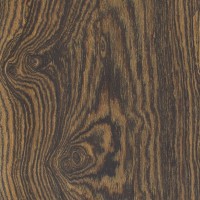 |
Common Name(s): Bocote Scientific Name: Cordia spp. Distribution: Mexico and Central/South America Tree Size: 65-100 ft (20-30 m) tall, 3-5 ft (1-1.5 m) trunk diameter Average Dried Weight: 53 lbs/ft3 (855 kg/m3) Specific Gravity (Basic, 12% MC): .68, .85 Janka Hardness: 2,010 lbf (8,950 N) Modulus of Rupture: 16,590 lbf/in2 (114.4 MPa) Elastic Modulus: 1,767,000 lbf/in2 (12.19 GPa) Crushing Strength: 8,610 lbf/in2 (59.4 MPa) Shrinkage: Radial: 4.0%, Tangential: 7.4%, Volumetric: 11.6%, T/R Ratio: 1.9 |
Color/Appearance: Has a yellowish brown body with dramatic dark brown to almost black stripes. Color tends to darken with age. Also, the grain patterning can be quite striking, particularly on flatsawn areas. It’s not uncommon to see many “eyes” and other figuring in Bocote: though unlike knots, they do not seem to present any special challenges in machining.
Grain/Texture: Grain on most decorative pieces is usually figured in some way, and also tends to be interlocked, though pieces with plain and straight grain can also be found. Medium uniform texture and a naturally oily/waxy feel. Good natural luster.
Endgrain: Diffuse-porous; solitary and radial multiples; medium to large pores in no specific arrangement, few; tyloses and other mineral deposits (yellow/brown) common; parenchyma varies slightly between species, but is generally banded (marginal), as well as vasicentric, aliform (lozenge), and confluent; medium to wide rays, spacing normal to wide.
Rot Resistance: Heartwood is rated from moderately durable to very durable depending on the species; it is susceptible to insect attack.
Workability: Some species may contain silica that will dull cutters. On the whole, Bocote is easily worked and machined with good results. Although Bocote has a fairly high amount of natural oils present, gluing is usually problem-free. (See the article on gluing oily tropical hardwoods for more information.) Bocote also turns and finishes well.
Odor: Bocote has a moderate scent when being worked that resembles dill pickles.
Allergies/Toxicity: Bocote has been shown to cause cross reactions once an allergic sensitivity to certain woods has been developed. Woods that can cause initial sensitivity include: Pau Ferro, Macassar Ebony, Cocobolo, and most Rosewoods. See the articles Wood Allergies and Toxicity and Wood Dust Safety for more information.
Pricing/Availability: Likely to be somewhat expensive, close to other mid-to-high priced exotic hardwoods.
Sustainability: This wood species is not listed in the CITES Appendices or on the IUCN Red List of Threatened Species.
Common Uses: Fine furniture, cabinetry, flooring, veneer, boatbuilding, musical instruments, gunstocks, turned objects, and other small specialty wood items.
Comments: With its striking, zebra-like contrasts, and bold figuring, Bocote can be a very eye-catching wood. Bookmatching two consecutive panels can create symmetrical “faces” and other patterns in the wood, (though a relatively thin-kerf blade should be used to minimize the shift of the pattern). Bocote is generally used for its aesthetic attributes, rather than its mechanical ones—and although Bocote is by no means weak, its strength-to-weight ratio is below average. (It is roughly as stiff and strong as Hard Maple, even though Bocote is considerably heavier.)
Scans/Pictures: A special thanks to Steve Earis for providing the turned photo of this wood species.


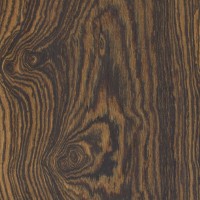
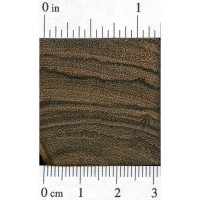
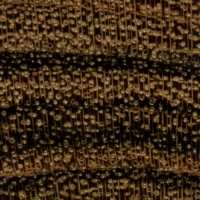
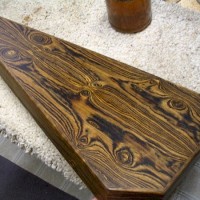
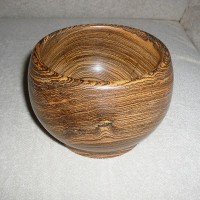



Possibly bocote? Got on clearance at Woodcraft
bocote snooker cue butt
Bocote baton.
Apakah ini bocote?
Used Bocote to make a comfort bird for some family. Beautiful wood, but was a bit hard for hand carving with just a knife.
What is the secret to finishing Bocote? My wipe on poly does not seem to cure, always tacky
Have you seen this article? https://www.wood-database.com/gluing-oily-tropical-hardwoods/
I finish with Tung oil and use multiple coats. First coat soaks in for 10 minutes, then wipe dry. Second coat after 12 hours. Polish by hand to beautiful luster. Add more coats and polish even shinier. Great finish I have found. Not affected by natural oils in the wood.
For this bird, I just used a mineral oil and beeswax mix. I also occasionally grab a little bead of beeswax and rub in on with bare hands. Works onto the wood and is a good fidget toy while watching TV or listening to a book.
kept it simple, used for a serving board, then used the leftovers for an acrylic mix board.
Has anyone used a different cordia species known basically as “cordia”? It doesn’t have the grain weave that “bocote” has and I’m curiious how this variety turns
I love bocote. I made this Apollo Infinity style pen with it today.
Carved this version of a Moai from a 1″ dowel.. the 1500 grit and coconut oil does wonders
? That is beautiful! Just bought an EVH Wolfgang Standard guitar with Bocote top and man, it’s gorgeous! Great work on your carving!
I just finished turning a bottle stopper made with bocote. It was my first time using this wood and I found that it worked easily on the lathe and finished nicely using CA finishes.
Here’s the picture of the bottle stopper. Not sure it wouldn’t go with the original posting?
Bocote I used as the edge of this cutting board (Limba and Wenge inside wood). It is really easy to work and finishes great. Love this wood. Pricey and can be hard to find.
Bocote and Flame Maple emergency box.
Bocote Earrings that I think take good advantage of the grain contrast
I am looking at using Bocote in making a Maloof inspired rocking chair. Concerned about the strength and grain at the rear and front legs. Any thoughts on using Bocote for a chair?
Thanks
M.C.
It’s plenty strong, not quite oak, but at least as strong as construction-grade fir. It’s quite heavy for its strength, which the original article mentions; however, for a given cross-sectional size, it’s quite a strong wood. It should be fine for chair legs.
Bocote has become my favorite for custom knife handles. Love it!
What did you use to finish your handle scales
Those look fantastic! I have a chunk of wood, I think I’ll try rehandling a knife.
I loved working it for a guitar. Resawed and planed without issue. Hard and dense but worked well with both power and hand tools. Glued without problem, bent surprisingly well – even on the tight cutaway. Looks great under French polish. I somehow didn’t realize until now that it is the same family as Ziricote, a highly sought after guitar wood.
Beautiful guitar Chuck!
Thank you!
Smooth exotic easy to carve hardwood for making custom designed sawhandles.
Bocote is awesome for handles, and even looks fine unfinished; as with this small toothpick holder.
Is there a toxicity to be aware of using this as the pot/bowl in tobacco pipes?
Eric, hi!
Is it true that another name for Bocote is Spanish elm? Is this the name of the tree in the United States?
Also, isn’t this Cordia gerascanthus? You write – Cordia spp.
https://tropical.theferns.info/viewtropical.php?id=Cordia%20gerascanthus
When it comes to common names used in commercial settings, I can really only give my direct experience based on the American market. Bocote is the common name used, I’ve never seen anything called Spanish elm for sale. The species most commonly associated with bocote is Cordia elaeagnoides, though I’m sure that other species are also included as well. In my opinion, what makes Cordia species worthy of the desirable trade name bocote (at least from an American perspective) is the interesting grain patterns. I’ve seen some wildly figured pieces, and they sold quickly. At the same time, I’ve seen… Read more »
I used bocote for dampers on the hammered dulcimer.The pinblocks are lacewood. I guess I can expect the bocote to darken, but hopefully not loose the stripes. This particular lacewood will become more orange brown with time.
Just used a small block of this wood to make some 1911 pistol grips. The grain looked so nice and turned out so good looking I left it sanded at 200 grit and finished it without any checkering. I’ll probably make all my high end gun stocks out of this now since it’s easy to work with and still being a strong wood.
Do you have any pics? Would be interesting to see.
I used Bicote for knife scales and the blade turned out amazing. Very striking figure and wonderful contrast between the grain. Easy to shape and doesn’t crack easily when drilled.
I just picked up some Bocote to rehandle a chef’s knife. I also grabbed a Bocote 1/8 x 3 x 24 to make a matching saya (sheath). Hoping it turns out as good as yours. Best, Fran
What’s suitable distance for planting?
I would like to be plant for commercial.
– Niran Yodying from Thailand
– rungto@gmail.com
Would this be a good wood for a cutting board? Thanks
It is a hardwood, so yes. However make sure the stock is well cured as it is a very oily wood and if green it can resist gluing.
I originally worked on this wood without checking this data base and I made a beautiful mechanical pencil out of it but I found it weird how when turning the wood I smelled a strong pickle smell funny to see that is common. Hear is the pencil next to a cocobolo pen a blood wood pen and a leopard wood pen
Hi Eric,
Your WOOD! book proudly occupies the prime real estate of my coffee table. It’s easily my favorite coffee table book. Thanks!
Anyway, I’ve got a few 2-3″ spheres of what I’m fairly certain is Bocote. However, they immediately sink when placed in water. Does that mean they are not Bocote?
Sorry I missed this the first time around. They certainly do look like Bocote. Do you know the relative humidity in your house? My guess it’s just slightly heavier than usual.
Those look a lot like Ipe to me, especially the close-up of the end-grain. Ipe usually has a density greater than 1 (so heavier than water). The Ipe that I’ve used doesn’t quite have as striking contrast between light and dark, though.
This wood is “Bocote” Common Name(s): Bocote
Scientific Name: Cordia spp. I would like to know In scientific name “spp.” what does it mean?
Thank you.
This should answer your question: https://www.wood-database.com/wood-articles/scientific-name/
Just means there are more than one species in the genus. Cordia is the genus.
Bocote is one of my favorite hardwoods.
I’ve yet to see a piece of Bocote that I could say was plain or ugly, or, just plain ugly.
It’s all beautiful.
Just bought a Chris Reeve Sebenza 21 knife with bocote inlays. It’s gorgeous!
Very lucky to have one of those, being in the uk it would be pointless for me getting one but I want one.
This species made some of my most beautiful taphandles . The “eyes” in the wood is one of a kind! The Waterlox finish worked wonderfully. More at https://www.halfyankeeworkshop.com
You said you use Waterlox to finish the wood. My attempts to finish the wood has ended in the finish remaining tacky and will not cure. Any thoughts?
Have you ever received a reply ?
I used Waterlox and did not have any problems. It does take about 4 days to cure completely.
I have used Walrus Oil Furniture Finish. Only let soak for about 15 minutes and then wipe dry. I have had outstanding results using this method.
Made a cribbage board out of white oak. Used Bacote for the bottom as
well as end trim on the game board. Stained the oak golden oak and it
looks really great. Great grain swirls and eyes in the Bacote.
My favorite wood species… when I can afford it. Use it on occasion in my woodworking business… Little Lumber Company, LLC.
Made a cribbage board out of white oak. Used Bacote for the bottom as well as end trim on the game board. Stained the oak golden oak and it looks really great. Great grain swirls and eyes in the Bacote.
project piece
My favorite wood species… when I can afford it. Use it on occasion in my woodworking business… Little Lumber Company, LLC.
just finished turning a pen and a pencil, easy wood to work with. beatiful grain patterns. LOVE IT!!
I took some fine chips of bocote and boiled them in hot water, smells alot like pickles.
Bocote makes a beautiful pistol grip, I have a set on order and can’t wait to see the finished project.